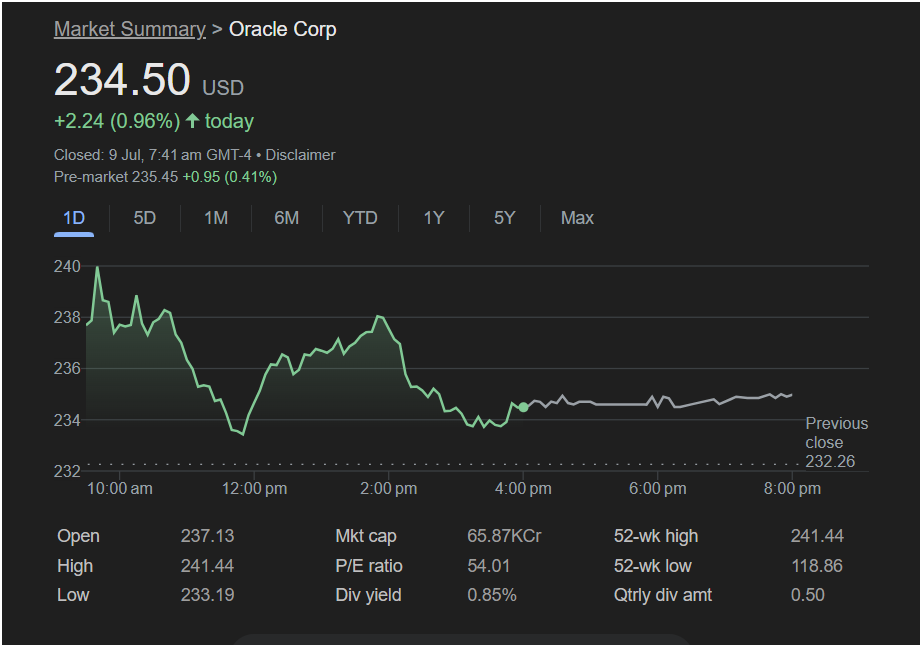Oracle Hits New All-Time High in Rollercoaster Session, Demonstrating Bullish Conviction Amid Extreme Volatility

AUSTIN, TX – July 9 – Oracle Corporation (NYSE: ORCL) delivered a dramatic and telling performance on the stock market Tuesday, a session that encapsulated the immense optimism and underlying tension surrounding the company’s aggressive pivot into the artificial intelligence infrastructure boom. Shares of the enterprise software titan rocketed to a new all-time high in the opening hour of trade, only to be slammed down in a wave of intense profit-taking, before clawing back to finish the day with a solid gain.
Oracle’s stock closed the official trading session at
2.24, which translates to a 0.96% rise for the day. While a gain of just under one percent might seem modest on the surface, the intraday journey to that closing print tells a far more compelling story of a fierce battle between long-term believers and short-term traders. The positive momentum appeared set to continue, with pre-market data as of 7:41 am GMT-4 showing the stock at
0.95 (0.41%).
The day was a microcosm of Oracle’s recent transformation in the eyes of Wall Street: a story of explosive potential, sky-high valuations, and the inherent volatility that comes when a legacy giant reinvents itself as a high-growth contender.
A Day of Wild Swings: The Intraday Narrative
Tuesday’s trading session for Oracle was anything but ordinary. The day began with palpable excitement, building on a previous close of
237.13. This powerful start was just the beginning. In a surge of buying pressure that can only be described as euphoric, investors piled into the stock, driving it relentlessly higher.
Within the first hour of trading, Oracle shares smashed through the
241.44**. This was not just an intraday peak; it was a new 52-week high and a new all-time record for the company. At that moment, Oracle was up nearly 4% on the day, a stunning move for a company of its scale.
However, what goes up in a parabolic fashion often faces a gravitational test. The new record high acted as a powerful psychological trigger for profit-taking. A flood of sell orders hit the market as investors who had ridden the stock’s incredible year-long rally decided to cash in their chips. The reversal was swift and brutal.
From its peak of $241.44, the stock entered a steep descent. It sliced back through the $240, $238, and
233.19**. This represented a staggering intraday swing of over $8 per share, or more than 3.4% from peak to trough. The stock that had been triumphantly positive was now briefly in negative territory compared to its previous close.
Yet, the bull thesis for Oracle proved resilient. At these lower levels, buyers re-emerged, seeing the dip as an opportunity. The afternoon was characterized by a slow, grinding recovery. The stock stabilized and methodically climbed back into positive territory, eventually settling at $234.50. The ability to absorb such a massive wave of selling and still close firmly in the green is a powerful testament to the underlying demand for the stock and the market’s conviction in its future.
The AI Gold Rush: Deconstructing Oracle’s Bull Thesis
The dramatic performance of Oracle’s stock is not happening in a vacuum. It is the direct result of a fundamental shift in the company’s business and Wall Street’s perception of its role in the new technological era. The key driver can be summarized in two letters: AI.
For years, Oracle was viewed as a mature, stable, but slow-growing giant, dominant in the world of enterprise databases but a laggard in the cloud computing race against Amazon’s AWS, Microsoft’s Azure, and Google’s Cloud. That narrative has been shattered over the past year.
Oracle’s Cloud Infrastructure (OCI) has emerged as a surprisingly powerful and cost-effective platform for training the massive large language models (LLMs) that power generative AI. This has led to a series of blockbuster deals and partnerships that have forced the market to re-evaluate the company’s growth trajectory completely. High-profile collaborations with AI leaders like OpenAI, Microsoft, and Google have served as a massive validation of OCI’s capabilities, signaling that Oracle is not just a participant but a critical enabler of the AI revolution.
This AI-driven narrative is directly reflected in the company’s valuation. The screenshot shows a Price-to-Earnings (P/E) ratio of 54.01. This is an exceptionally high multiple for a company of Oracle’s vintage. A P/E in the 50s is typically reserved for hyper-growth, early-stage tech companies, not established titans. This valuation clearly indicates that the market is no longer pricing Oracle based on its legacy database business. Instead, it is pricing in years of explosive growth from its cloud and AI segments, betting that the recent surge in demand is not a temporary blip but the beginning of a new, long-term growth S-curve.
A Closer Look at the Financial Vitals
The data presented in the screenshot provides further crucial context for Oracle’s current standing.
-
Market Capitalization: The figure of 65.87KCr (likely a notation for 65,870 crore in the Indian numbering system) suggests a market capitalization in the hundreds of billions of dollars. With its stock price at these levels, Oracle’s market value stands at roughly $660 billion, placing it firmly in the elite club of the world’s most valuable technology companies.
-
52-Week Performance: The day’s high of $241.44 being the new 52-week high is profoundly significant. It signals a powerful uptrend with strong momentum. This is contrasted with its 52-week low of $118.86. This means that in less than a year, the stock has more than doubled, delivering spectacular returns for investors and underscoring the dramatic repricing of the company by the market.
-
Dividend Policy: A Sign of Confidence: The screenshot reveals a dividend yield of 0.85% and a quarterly dividend amount of $0.50. This is a particularly insightful data point. A yield below 1% might seem low, but it is the change in the quarterly amount that speaks volumes. Oracle recently raised its dividend by a substantial 25% from $0.40 to $0.50 per share. This is an incredibly bullish signal from management. It communicates supreme confidence in the company’s future cash flow generation. It tells investors that Oracle believes it can fund its massive investments in new data centers to meet AI demand and simultaneously return a significantly larger amount of capital to its shareholders. This dual commitment to growth and shareholder returns is a powerful combination that appeals to a broad base of investors.
The Outlook: Balancing on a High Wire
Oracle’s stock now finds itself in a fascinating and precarious position. The bull and bear cases are both compelling.
The Bull Case: Proponents will argue that the market is finally waking up to the reality of Oracle’s technological prowess. The partnerships with major AI players are just the beginning, and as more companies seek to build and deploy their own AI models, they will flock to OCI for its performance and cost advantages. In this view, the P/E of 54, while high, is justified because Oracle is on the cusp of a multi-year super-cycle of growth that will see its earnings expand dramatically, eventually “growing into” its valuation. The stock’s resilience during Tuesday’s session, where it absorbed a massive bout of selling, is seen as proof of a strong and committed buyer base.
The Bear Case: Skeptics, however, will point to the P/E ratio of 54 as a sign of dangerous froth and irrational exuberance. They will argue that the stock has come too far, too fast, and is priced for a level of perfection that leaves no room for error. The competition in the cloud space remains ferocious, and there is no guarantee that Oracle can maintain its current momentum against the deeply entrenched hyperscale rivals. Any sign of a slowdown in AI spending, a delayed data center buildout, or a disappointing quarterly earnings report could violently prick the valuation bubble, leading to a sharp and painful correction. The midday plunge on Tuesday serves as a stark warning of how quickly sentiment can turn and how much downside risk exists from these elevated levels.
In conclusion, Tuesday’s trading session was a theatrical display of the forces shaping Oracle’s destiny. The surge to a new all-time high confirmed the power of its AI-driven growth story, while the subsequent plunge and recovery highlighted the extreme volatility and investor nervousness surrounding its lofty valuation. The stock’s ability to finish in the green was a victory for the bulls, but the session also served as a clear reminder that Oracle is walking a high wire. Its future performance now hinges entirely on its ability to execute flawlessly and deliver on the monumental expectations that are now priced into its shares.






